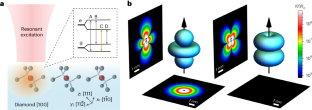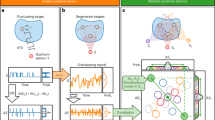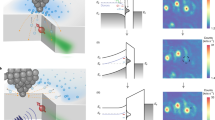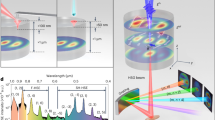Abstract
A resonantly excited atomic optical dipole simultaneously generates propagating (far) and evanescent (near) electromagnetic fields. The near-field component diverges in the limit of decreasing distance, indicating an optical antenna with the potential for enormous near-field intensity enhancement. In principle, any atomic optical dipole in a solid can serve as an optical antenna; however, most of them suffer from environmentally induced decoherence that largely mitigates field enhancement. Here we demonstrate that germanium vacancy centres in diamond—optically coherent atom-like dipoles in a solid—are exemplary antennas. We measure up to million-fold optical intensity enhancement in the near-field of resonantly excited germanium vacancies. In addition to the rich applications already developed for conventional nanoantennas, atomic antennas in the solid state promise to yield interesting new applications in spectroscopy, sensing and quantum science. As one concrete example, we use germanium vacancy antennas to detect and control the charge state of nearby carbon vacancies and generate measurable fluorescence from individual vacancies through Förster resonance energy transfer.
This is a preview of subscription content, access via your institution
Access options
Access Nature and 54 other Nature Portfolio journals
Get Nature+, our best-value online-access subscription
$32.99 / 30 days
cancel any time
Subscribe to this journal
Receive 12 print issues and online access
$259.00 per year
only $21.58 per issue
Buy this article
- Purchase on SpringerLink
- Instant access to full article PDF
Prices may be subject to local taxes which are calculated during checkout





Similar content being viewed by others
Data availability
The datasets generated and/or analysed during the current study are available from the corresponding author on reasonable request.
References
Taminiau, T., Stefani, F., Segerink, F. B. & Van Hulst, N. Optical antennas direct single-molecule emission. Nat. Photon. 2, 234–237 (2008).
Liu, N., Tang, M. L., Hentschel, M., Giessen, H. & Alivisatos, A. P. Nanoantenna-enhanced gas sensing in a single tailored nanofocus. Nat. Mater. 10, 631–636 (2011).
Sobhani, A. et al. Narrowband photodetection in the near-infrared with a plasmon-induced hot electron device. Nat. Commun. 4, 1643 (2013).
Le Ru, E. C. & Etchegoin, P. G. Single-molecule surface-enhanced raman spectroscopy. Ann. Rev. Phys. Chem. 63, 65–87 (2012).
Swearer, D. F. et al. Heterometallic antenna–reactor complexes for photocatalysis. Proc. Natl Acad. Sci. USA 113, 8916–8920 (2016).
Novotny, L. & Hecht, B. Principles of Nano-Optics (Cambridge Univ. Press, 2012).
Knall, E. N. et al. Efficient source of shaped single photons based on an integrated diamond nanophotonic system. Phys. Rev. Lett. 129, 053603 (2022).
Hepp, C. et al. Electronic structure of the silicon vacancy color center in diamond. Phys. Rev. Lett. 112, 036405 (2014).
Jantzen, U. et al. Nanodiamonds carrying silicon-vacancy quantum emitters with almost lifetime-limited linewidths. New J. Phys. 18, 073036 (2016).
Bhaskar, M. K. et al. Quantum nonlinear optics with a germanium-vacancy color center in a nanoscale diamond waveguide. Phys. Rev. Lett. 118, 223603 (2017).
Trusheim, M. E. et al. Transform-limited photons from a coherent tin-vacancy spin in diamond. Phys. Rev. Lett. 124, 023602 (2020).
Siyushev, P. et al. Optical and microwave control of germanium-vacancy center spins in diamond. Phys. Rev. B 96, 081201 (2017).
Sipahigil, A. et al. An integrated diamond nanophotonics platform for quantum-optical networks. Science 354, 847–850 (2016).
Guo, X. et al. Tunable and transferable diamond membranes for integrated quantum technologies. Nano Lett. 21, 10392–10399 (2021).
Miller, O. D. et al. Fundamental limits to optical response in absorptive systems. Opt. Express 24, 3329–3364 (2016).
Christiansen, R. E., Michon, J., Benzaouia, M., Sigmund, O. & Johnson, S. G. Inverse design of nanoparticles for enhanced raman scattering. Opt. Express 28, 4444–4462 (2020).
Maity, S. et al. Spectral alignment of single-photon emitters in diamond using strain gradient. Phys. Rev. Appl. 10, 024050 (2018).
Bergamin, M. et al. in Quantum Information and Measurement Th2C–6 (Optical Society of America, 2021).
Subedi, S., Fedorov, V., Mirov, S. & Markham, M. Spectroscopy of gr1 centers in synthetic diamonds. Opt. Mater. Express 11, 757–765 (2021).
Baldwin Jr, J. A. Electron paramagnetic resonance investigation of the vacancy in diamond. Phys. Rev. Lett. 10, 220 (1963).
Davies, G. Charge states of the vacancy in diamond. Nature 269, 498–500 (1977).
Heremans, F., Fuchs, G., Wang, C., Hanson, R. & Awschalom, D. Generation and transport of photoexcited electrons in single-crystal diamond. Appl. Phys. Lett. 94, 152102 (2009).
Wolfowicz, G. et al. Optical charge state control of spin defects in 4H-SiC. Nat. Commun. 8, 1876 (2017).
Ohno, K. et al. Engineering shallow spins in diamond with nitrogen delta-doping. Appl. Phys. Lett. 101, 082413 (2012).
Rugar, A. E. et al. Generation of tin-vacancy centers in diamond via shallow ion implantation and subsequent diamond overgrowth. Nano Lett. 20, 1614–1619 (2020).
Tisler, J. et al. Highly efficient fret from a single nitrogen-vacancy center in nanodiamonds to a single organic molecule. ACS Nano 5, 7893–7898 (2011).
Nelz, R. et al. Near-field energy transfer between a luminescent 2D material and color centers in diamond. Adv. Quant. Technol. 3, 1900088 (2020).
Kong, X., Nir, E., Hamadani, K. & Weiss, S. Photobleaching pathways in single-molecule FRET experiments. J. Am. Chem. Soc. 129, 4643–4654 (2007).
Roy, R., Hohng, S. & Ha, T. A practical guide to single-molecule FRET. Nat. Methods 5, 507–516 (2008).
Novotny, L. & Van Hulst, N. Antennas for light. Nat. Photon. 5, 83–90 (2011).
Michon, J., Benzaouia, M., Yao, W., Miller, O. D. & Johnson, S. G. Limits to surface-enhanced Raman scattering near arbitrary-shape scatterers. Opt. Express 27, 35189–35202 (2019).
Mie, G. Beiträge zur optik trüber medien, speziell kolloidaler metallösungen. Ann. Phys. 330, 377–445 (1908).
Neves, A. A. R., Cesar, C. L., Garbos, M. K., Euser, T. G. & Moreira, W. L. Expansion of arbitrary electromagnetic fields in terms of vector spherical wave functions. Opt. Express 24, 2370–2382 (2016).
Chen, Y. et al. Ultralow-power cryogenic thermometry based on optical-transition broadening of a two-level system in diamond. ACS Photon. 10, 2481–2487 (2023).
Feng, L. et al. Silver-coated elevated bowtie nanoantenna arrays: improving the near-field enhancement of gap cavities for highly active surface-enhanced Raman scattering. Nano Res. 8, 3715–3724 (2015).
Fischer, H. & Martin, O. J. F. Engineering the optical response of plasmonic nanoantennas. Opt. Express 16, 9144–9154 (2008).
Li, K., Stockman, M. I. & Bergman, D. J. Self-similar chain of metal nanospheres as an efficient nanolens. Phys. Rev. Lett. 91, 227402 (2003).
Dengchao, H. et al. Metal–insulator–metal nanoislands with enhanced local fields for SERS-based detection. ACS Appl. Nano Mater. 18, 16856–16863 (2023).
Michaels, A. M., Jiang, J. & Brus, L. Ag nanocrystal junctions as the site for surface-enhanced Raman scattering of single rhodamine 6G molecules. J. Phys. Chem. B 104, 11965–11971 (2000).
Wang, P. et al. Transform-limited photon emission from a lead-vacancy center in diamond above 10 K. Phys. Rev. Lett. 132, 073601 (2023).
Smith, J. M., Meynell, S. A., Bleszynski Jayich, A. C. & Meijer, J. Colour centre generation in diamond for quantum technologies. Nanophotonics 8, 1889–1906 (2019).
McLellan, C. A. et al. Patterned formation of highly coherent nitrogen-vacancy centers using a focused electron irradiation technique. Nano Lett. 16, 2450–2454 (2016).
Janitz, E., Bhaskar, M. K. & Childress, L. Cavity quantum electrodynamics with color centers in diamond. Optica 7, 1232–1252 (2020).
Gottscholl, A. et al. Room temperature coherent control of spin defects in hexagonal boron nitride. Sci. Adv. 7, eabf3630 (2021).
Anderson, C. P. et al. Five-second coherence of a single spin with single-shot readout in silicon carbide. Sci. Adv. 8, eabm5912 (2022).
Zhong, T., Kindem, J. M., Miyazono, E. & Faraon, A. Nanophotonic coherent light–matter interfaces based on rare-earth-doped crystals. Nat. Commun. 6, 8206 (2015).
Bayliss, S. et al. Enhancing spin coherence in optically addressable molecular qubits through host-matrix control. Phys. Rev. X 12, 031028 (2022).
Moerner, W. E. & Kador, L. Optical detection and spectroscopy of single molecules in a solid. Phys. Rev. Lett. 62, 2535 (1989).
Diez, D. M., Barr, C. D. & Cetinkaya-Rundel, M. OpenIntro Statistics (OpenIntro Boston, 2012).
Fan, X., Zheng, W. & Singh, D. J. Light scattering and surface plasmons on small spherical particles. Light Sci. Appl. 3, e179–e179 (2014).
Alaee, R., Rockstuhl, C. & Fernandez-Corbaton, I. Exact multipolar decompositions with applications in nanophotonics. Adv. Opt. Mater. 7, 1800783 (2019).
Aharonovich, I. et al. Homoepitaxial growth of single crystal diamond membranes for quantum information processing. Adv. Mater. 24, OP54–OP59 (2012).
Perdew, J. P., Burke, K. & Ernzerhof, M. Generalized gradient approximation made simple. Phys. Rev. Lett. 77, 3865 (1996).
Giannozzi, P. et al. Quantum espresso: a modular and open-source software project for quantum simulations of materials. J. Phys. Condens. Matter 21, 395502 (2009).
Giannozzi, P. et al. Quantum espresso toward the exascale. J. Chem. Phys. 152, 154105 (2020).
Hamann, D. Optimized norm-conserving Vanderbilt pseudopotentials. Phys. Rev. B 88, 085117 (2013).
Schlipf, M. & Gygi, F. Optimization algorithm for the generation of oncv pseudopotentials. Comput. Phys. Commun. 196, 36–44 (2015).
Acknowledgements
We acknowledge funding from Q-NEXT, supported by the US Department of Energy, Office of Science, National Quantum Information Science Research Centers. Z.L. acknowledges support from the Kadanoff-Rice fellowship (grant no. NSF DMR-2011854). Diamond growth-related efforts were supported by the US Department of Energy, Office of Basic Energy Sciences, Materials Science and Engineering Division (N.D.). The membrane bonding work is supported by NSF award no. AM-2240399. This work made use of the Pritzker Nanofabrication Facility (Soft and Hybrid Nanotechnology Experimental Resource, NSF award no. ECCS-2025633) and the Materials Research Science and Engineering Center (NSF award no. DMR-2011854) at the University of Chicago. F.A. acknowledges support from the ICFOstepstone—PhD Programme funded by the European Union’s Horizon 2020 Research and Innovation programme under Marie Skłodowska-Curie grant agreement no. 713729. D.C. acknowledges support from the European Union’s Horizon 2020 Research and Innovation programme, under European Research Council grant agreement no. 101002107 (NEWSPIN); the Government of Spain (Severo Ochoa grant no. CEX2019-000910-S); Generalitat de Catalunya (CERCA program and AGAUR project no. 2021 SGR 01442); and Fundació Cellex and Fundació Mir-Puig. First-principles calculations were performed in the MICCoM center—a computational materials science centre funded by the US Department of Energy, Office of Basic Energy Sciences, and used resources of the University of Chicago Research Computing Center.
Author information
Authors and Affiliations
Contributions
Z.L. and X.G. performed the experiments and analysed the data. Y.J. and A.B. performed first-principles calculations under the supervision of G.G. F.A. performed near-field calculations under the supervision of D.C. D.D.A., N.D. and F.J.H. provided the materials. A.A.H. conceived and supervised the project. All authors discussed the results and contributed to the paper.
Corresponding author
Ethics declarations
Competing interests
The authors declare no competing interests.
Peer review
Peer review information
Nature Photonics thanks the anonymous reviewers for their contribution to the peer review of this work.
Additional information
Publisher’s note Springer Nature remains neutral with regard to jurisdictional claims in published maps and institutional affiliations.
Supplementary information
Supplementary Information
Supplementary Figs. 1–10, Discussion and Table 1.
Rights and permissions
Springer Nature or its licensor (e.g. a society or other partner) holds exclusive rights to this article under a publishing agreement with the author(s) or other rightsholder(s); author self-archiving of the accepted manuscript version of this article is solely governed by the terms of such publishing agreement and applicable law.
About this article
Cite this article
Li, Z., Guo, X., Jin, Y. et al. Atomic optical antennas in solids. Nat. Photon. 18, 1113–1120 (2024). https://doi.org/10.1038/s41566-024-01456-5
Received:
Accepted:
Published:
Issue date:
DOI: https://doi.org/10.1038/s41566-024-01456-5
This article is cited by
-
Quantum electrometer for time-resolved material science at the atomic lattice scale
Nature Communications (2025)
-
Ångström-tunable polarization-resolved solid-state photon sources
Nature Photonics (2025)
-
Diamond colour centre enables an atomic optical antenna
Nature Photonics (2024)



